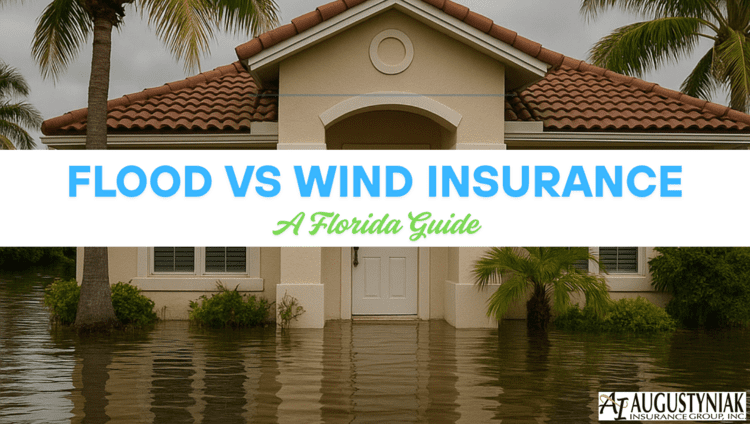
🕒 Estimated Read Time: 4 minutes
🌪️What’s the difference between wind and flood damage?
Living in Florida, it’s not unusual for one storm to cause a lot of different kinds of damage. A hurricane might tear off roof shingles, break windows, and then push several feet of water into your home from storm surge. When that happens, you’re dealing with both wind damage and flood damage, and the way insurance handles those two things is very different.
That’s the part that surprises a lot of people. You might assume one policy will cover everything, but wind damage and flood damage are covered by two different insurance policies. Understanding how each type of damage is treated can make the claims process a lot easier—and help you avoid surprises.
🏠 How Wind Damage and Flood Damage Are Handled by Insurance
When we talk about wind damage, we mean things like rain blowing into your home through a damaged roof, broken windows caused by flying debris, or even an entire roof being lifted off by strong gusts. This type of damage is typically covered by your homeowners insurance policy.
Flood damage is entirely different—and it’s not covered by homeowners insurance. To be protected against flood-related losses, you’ll need a separate flood insurance policy, either through FEMA’s National Flood Insurance Program (NFIP) or a private flood insurer. Flooding usually refers to rising water that enters your home from storm surge, heavy rain, overflowing streets, or backed-up drainage systems. It often affects the lowest levels of your home—your floors, baseboards, drywall, and furniture.
If your home is damaged by both wind and flood in the same storm, you’ll likely need to file two separate insurance claims—one with your homeowners insurance and one with your flood insurer.
Bottom line: Wind and flood insurance claims are handled separately. Having detailed documentation (including photos of the damage) can make all the difference when filing claims.
🏠 What Counts as Wind Damage?
Wind damage is usually caused by high hurricane winds, tornadoes, flying debris, or wind-driven rain. This type of damage is covered by your homeowners insurance policy and can include:
- Roof leaks or missing shingles
- Rainwater entering through damaged roofs or windows
- Broken doors or siding
- Structural damage from fallen trees or limbs
💧 What Counts as Flood Damage?
Flood damage, on the other hand, is caused by rising water—and it's not covered by your homeowners insurance. You’ll need a separate flood insurance policy to be protected. This policy may come through FEMA’s National Flood Insurance Program (NFIP) or a private insurer. Flood damage includes:
- Storm surge or rising water entering your home
- Overflow from canals, rivers, or heavy rain
- Saturated flooring, baseboards, and drywall from ground-level water
So if a hurricane hits and your home is damaged by both wind and flood, you'll likely need to file two claims—one for each policy.
If the damage is below the water mark, it’s usually considered flood damage—covered by flood insurance.
If it’s above the water mark, it may be wind-driven rain—covered by your homeowners insurance.
Take clear photos of the water line in each room before you clean or discard anything.
🧱 What Is a Water Mark—and Why Does It Matter for Insurance?
After floodwater recedes, it often leaves a line on your walls or furniture. This line is called a watermark (or water line). It shows how high the water rose inside your home.
Common signs of a watermark include:
- A horizontal line of dirt or discoloration on your walls
- Discolored paint or wallpaper starting to peel
- Warped or swollen furniture, baseboards, or cabinets
Insurance adjusters use the water mark to help determine which damage was caused by flooding versus wind or rain. Here’s the general rule:
| Damage Location | Likely Type | Covered By |
|---|---|---|
| Below the water mark | Flood damage | Flood Insurance |
| Above the water mark | Wind-related rain | Homeowners Insurance |
For example, if water damaged your drywall up to 24 inches, that’s usually flood damage. But if the ceiling is also leaking, that could be from wind-driven rain—and covered by your home insurance.
📸 After the Storm: What Should You Do?
Once it's safe to go inside, take clear photos and videos of all damage before moving or cleaning anything. Here's what to capture:
- The water line in every affected room
- Any roof, window, or exterior damage
- Damaged floors, walls, furniture, and personal items
- Serial numbers or identifying details on large appliances or electronics
Hold onto anything damaged, if possible. If you need to dispose of it, document it first. Photos will be key when filing claims and proving the cause of damage.
🤝 Need Help With a Claim or Policy Review?
We know how overwhelming it can be after a hurricane. If you’re not sure what your current policies cover—or if you’re filing both a flood and wind claim—our local team is here to help.
We’ll explain what’s covered, walk you through the process, and help you get the support you need.
📞 Let’s Make Sure You’re Covered
If a hurricane hit tomorrow, would you be covered for both wind and flood? Let’s talk about it now—before the storm hits.
👉 Request a Flood Insurance Quote
📱 Or call us today. We’re local, and we’re ready when you need us.

Discussion
There are no comments yet.